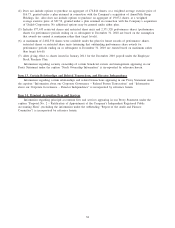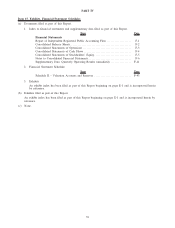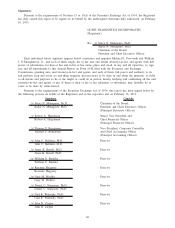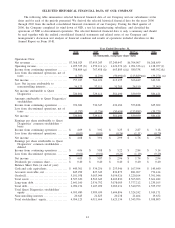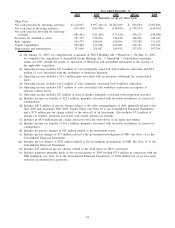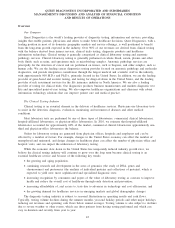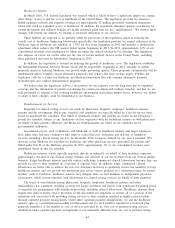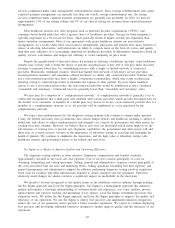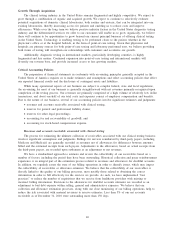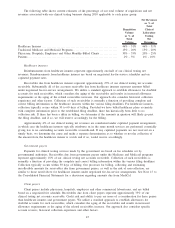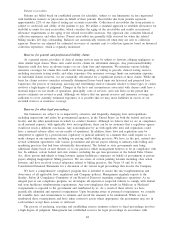Quest Diagnostics 2010 Annual Report Download - page 50
Download and view the complete annual report
Please find page 50 of the 2010 Quest Diagnostics annual report below. You can navigate through the pages in the report by either clicking on the pages listed below, or by using the keyword search tool below to find specific information within the annual report.
The following table shows current estimates of the percentage of our total volume of requisitions and net
revenues associated with our clinical testing business during 2010 applicable to each payer group:
Requisition
Volume
as % of
Total
Volume
Net Revenues
as % of
Total
Clinical
Laboratory
Testing
Net
Revenues
Healthcare Insurers . ........................................................... 46% - 51% 46% - 51%
Traditional Medicare and Medicaid Programs . . . ................................ 15% - 20% 15% - 20%
Physicians, Hospitals, Employers and Other Monthly-Billed Clients . ............. 30% - 35% 20% - 25%
Patients . . . .................................................................... 2% - 5% 4% - 10%
Healthcare insurers
Reimbursements from healthcare insurers represent approximately one-half of our clinical testing net
revenues. Reimbursements from healthcare insurers are based on negotiated fee-for-service schedules and on
capitated payment rates.
Receivables due from healthcare insurers represent approximately 27% of our clinical testing net accounts
receivable. Substantially all of the accounts receivable due from healthcare insurers represent amounts billed
under negotiated fee-for-service arrangements. We utilize a standard approach to establish allowances for doubtful
accounts for such receivables, which considers the aging of the receivables and results in increased allowance
requirements as the aging of the related receivables increases. Our approach also considers historical collection
experience and other factors. Collection of such receivables is normally a function of providing complete and
correct billing information to the healthcare insurers within the various filing deadlines. For healthcare insurers,
collection typically occurs within 30 to 60 days of billing. Provided we have billed healthcare plans accurately
with complete information prior to the established filing deadline, there has historically been little to no
collection risk. If there has been a delay in billing, we determine if the amounts in question will likely go past
the filing deadline, and if so, we will reserve accordingly for the billing.
Approximately 4% of our clinical testing net revenues are reimbursed under capitated payment arrangements,
in which case the healthcare insurers typically reimburse us in the same month services are performed, essentially
giving rise to no outstanding accounts receivable at month-end. If any capitated payments are not received on a
timely basis, we determine the cause and make a separate determination as to whether or not the collection of
the amount from the healthcare insurer is at risk and if so, would reserve accordingly.
Government payers
Payments for clinical testing services made by the government are based on fee schedules set by
governmental authorities. Receivables due from government payers under the Medicare and Medicaid programs
represent approximately 18% of our clinical testing net accounts receivable. Collection of such receivables is
normally a function of providing the complete and correct billing information within the various filing deadlines.
Collection typically occurs within 30 days of billing. Our processes for billing, collecting and estimating
uncollectible amounts for receivables due from government payers, as well as the risk of non-collection, are
similar to those noted above for healthcare insurers under negotiated fee-for-service arrangements. See Note 15 to
the Consolidated Financial Statements for a discussion regarding amounts due from MediCal.
Client payers
Client payers include physicians, hospitals, employers and other commercial laboratories, and are billed
based on a negotiated fee schedule. Receivables due from client payers represent approximately 33% of our
clinical testing net accounts receivable. Credit risk and ability to pay are more of a consideration for these payers
than healthcare insurers and government payers. We utilize a standard approach to establish allowances for
doubtful accounts for such receivables, which considers the aging of the receivables and results in increased
allowance requirements as the aging of the related receivables increase. Our approach also considers specific
account reviews, historical collection experience and other factors.
47



